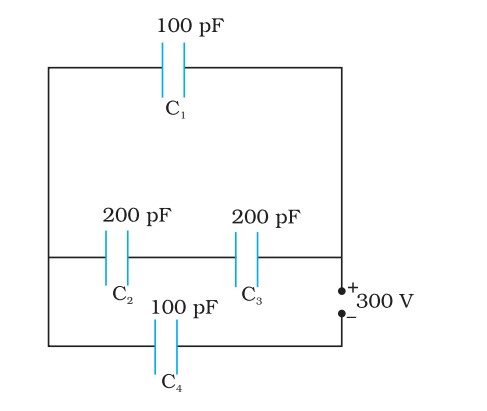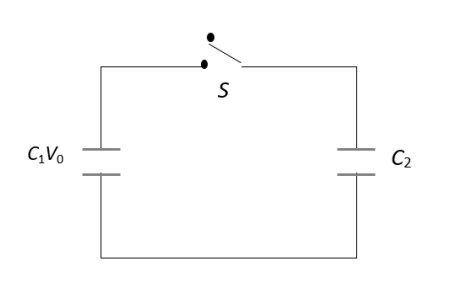Class 12 CBSE Physics Specimen Question Paper 2024
Maximum Marks: 70
Time Allowed: Three hours
There are 35 questions in all. All questions are compulsory
This question paper has five sections: Section A, Section B, Section C, Section D and
Section E. All the sections are compulsory.
Section A contains eighteen MCQ of 1 mark each, Section B contains seven questions
of two marks each, Section C contains five questions of three marks each, section D
contains three long questions of five marks each and Section E contains two case study
based questions of 4 marks each.
There is no overall choice. However, an internal choice has been provided in section
B, C, D and E. You have to attempt only one of the choices in such questions.
5. Use of calculators is not allowed.
Section-A
Question 1
Which of the following is not the property of an equipotential surface?
(a) They do not cross each other.
(b) The work done in carrying a charge from one point to another on an
equipotential surface is zero.
(c ) For a uniform electric field, they are concentric spheres.
(d) They can be imaginary spheres
Question 2
An electric dipole placed in an electric field of intensity 2 × 105 N/C at an angle of
30° experiences a torque equal to 4 Nm. The charge on the dipole of dipole length
2 cm is
(a) 7 µC (b) 8 mC (c) 2 mC (d) 5 mC
Question 3
A metallic plate exposed to white light emits electrons. For which of the following
colours of light, the stopping potential will be maximum?
(a) Blue (b) Yellow (c) Red (d) Violet
Question 4
When alpha particles are sent through a thin gold foil, most of them go straight
through the foil, because
(a) alpha particles are positively charged
(b) the mass of an alpha particle is more than the mass of an electron
(c) most of the part of an atom is empty space
(d) alpha particles move with high velocity
Question 5
An electron is moving along positive x-axis in a magnetic field which is parallel
to
the positive y-axis. In what direction will the magnetic force be acting on the
electron?
(a) Along -x axis (b) Along -z axis
(c ) Along +z axis (d) Along -y axis
Question 6
The relative magnetic permeability of a substance X is slightly less than unity and
that of substance Y is slightly more than unity, then
(a) X is paramagnetic and Y is ferromagnetic
(b) X is diamagnetic and Y is ferromagnetic
(c) X and Y both are paramagnetic
(d) X is diamagnetic and Y is paramagnetic
Question 7
An ammeter of resistance 0.81 ohm reads up to 1 A. The value of the
required shunt to increase the range to 10 A is
(a) 0.9 ohm (b ) 0.09 ohm (c) 0.03 ohm (d) 0.3 ohm
Question 8
An electron with angular momentum L moving around the nucleus has a
magnetic moment given by
(a) e L/ 2m (b) e L/3m (c) e L /4m (d) e L / m
Question 9
The large scale transmission of electrical energy over long distances is done with
the use of transformers. The voltage output of the generator is stepped-up because
of
(a) reduction of current (b) reduction of current and voltage both
(c) power loss is cut down (d) (a ) and (c) both
Question 10
The diagram below shows the electric field (E) and magnetic field (B) components
of an electromagnetic wave at a certain time and location.
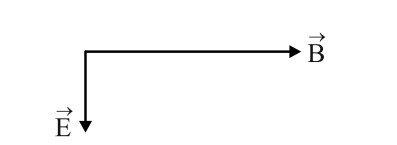
The direction of the propagation of the electromagnetic wave is
(a) perpendicular to E and B and out of plane of the paper
(b) perpendicular to E and B and into the plane of the paper
(c) parallel and in the same direction as E
(d) parallel and in the same direction as B
Question 11
In a coil of resistance 100 Ω a current is induced by changing the magnetic
flux through it. The variation of current with time is as shown in the figure. The
magnitude of change in flux through coil is

(a) 200 Wb (b) 275 Wb (c) 225 Wb (d) 250 Wb
Question 12
The energy of an electron in nth orbit of hydrogen atom is En= - 13.6/𝑛
2𝑒𝑉.The
negative sign of energy indicates that
(a) electron is free to move.
(b) electron is bound to the nucleus.
(c) kinetic energy of electron is equal to potential energy of electron.
(d) atom is radiating energy
For Questions
13 to 16, two statements are given –one labelled Assertion (A) and other
labelled Reason (R). Select the correct answer to these questions from the options as
given below.
a) If both Assertion and Reason are true and Reason is correct explanation of
Assertion.
b) If both Assertion and Reason are true but Reason is not the correct
explanation of Assertion.
c) If Assertion is true but Reason is false.
d) If both Assertion and Reason are false.
Question 13
Assertion (A): For the radiation of a frequency greater than the threshold
frequency,
photoelectric current is proportional to the intensity of the radiation.
Reason (R) : Greater the number of energy quanta available, greater is the
number of electrons absorbing the energy quanta and greater
is number of electrons coming out of the metal.
Question 14
Assertion (A) : Putting p type semiconductor slab directly in physical contact
with n type semiconductor slab cannot form the pn junction.
Reason (R) : The roughness at contact will be much more than inter atomic
crystal spacing and continuous flow of charge carriers is not
possible
Question 15
Assertion (A) : An electron has a higher potential energy when it is at a location
associated with a negative value of potential and has a lower
potential energy when at a location associated with a positive
potential.
Reason (R) : Electrons move from a region of higher potential to a region of
lower potential.
Question 16
Assertion (A) : Propagation of light through an optical fibre is due to total
internal reflection taking place at the core-cladding interface.
Reason (R): Refractive index of the material of the cladding of the optical fibre
is greater than that of the core
SECTION-B
Question 17
(a) Name the device which utilizes unilateral action of a pn diode to convert
ac into dc.
(b) Draw the circuit diagram of full wave rectifier.
Question 18
The wavelength λ of a photon and the de Broglie wavelength of an electron of mass m have the same value. Show that the energy of the photon is 2λmc/h times the kinetic energy of the electron, where c and h have their usual meanings
Question 19
A ray of monochromatic light passes through an equilateral glass prism in such a way that the angle of incidence is equal to the angle of emergence and each of these angles is 3/4 times the angle of the prism. Determine the angle of deviation and the refractive index of the glass prism
Question 20
A heating element using nichrome connected to a 230 V supply draws an initial current of 3.2 A which settles after a few seconds to a steady value of 2.8 A. What is the steady temperature of the heating element if the room temperature is 27.0 °C and the temperature coefficient of resistance of nichrome is 1.70 × 10-4 °C-1 ?
Question 21
Show that the least possible distance between an object and its real image in a
convex lens is 4f, where f is the focal length of the lens.
OR
In an astronomical telescope in normal adjustment a straight black line of length L is
drawn on the objective lens. The eyepiece forms a real image of this line whose
length is 𝑙. What is the angular magnification of the telescope?
SECTION-C
Question 22
A given coin has a mass of 3.0 g. Calculate the nuclear energy that would be required to separate all the neutrons and protons from each other. For simplicity assume that the coin is entirely made of 2963𝐶𝑢 atoms (of mass 62.92960 u). Given mp = 1.007825u and mn = 1.008665u.
Question 23
Charges (+q) and (–q) are placed at the points A and B respectively which are a
distance 2L apart. C is the midpoint between A and B. What is the work done in
moving a charge +Q along the semicircle CRD.
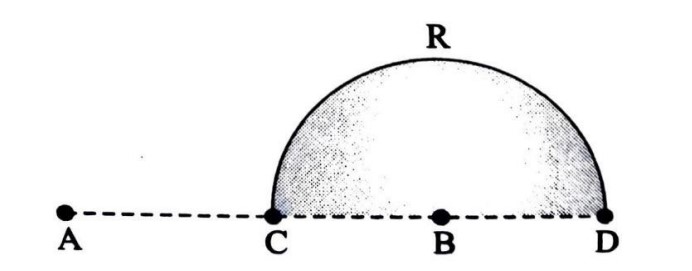
Question 24
The total energy of an electron in the first excited state of the hydrogen atom is
about –3.4 eV.
(a) What is the kinetic energy of the electron in this state?
(b) What is the potential energy of the electron in this state?
(c) Which of the answers above would change if the choice of the zero of potential
energy is changed?
Question 25
A wire of uniform cross-section and resistance 4 ohm is bent in the shape of square
ABCD. Point A is connected to a point P on DC by a wire AP of resistance 1 ohm.
When a potential difference is applied between A and C, the points B and P are seen
to be at the same potential. What is the resistance of the part DP?

Question 26
The given figure shows a long straight wire of a circular cross-section (radius a)
carrying steady current I. The current I is uniformly distributed across this crosssection. Calculate
the magnetic field in the region r < a and r> a.

Question 27
Identify the part of the electromagnetic spectrum which:
a) produces heating effect,
b) is absorbed by the ozone layer in the atmosphere,
c) is used for studying crystal structure.
Write any one method of the production of each of the above radiations.
Question 28
a. Define mutual inductance and write its SI unit.
b. Two circular loops, one of small radius r and other of larger radius R, such that
R >> r, are placed coaxially with centres coinciding. Obtain the mutual inductance of
the arrangement.
OR
Two long straight parallel current carrying conductors are kept ‘a’ distant apart in air.
The direction of current in both the conductors is same. Find the magnitude of force
per unit length and direction of the force between them. Hence define one ampere.



SECTION-D
Question 29
Read the following paragraph and answer the questions that follow.
A semiconductor diode is basically a pn junction with metallic contacts provided at
the ends for the application of an external voltage. It is a two terminal device. When
an external voltage is applied across a semiconductor diode such that p-side is
connected to the positive terminal of the battery and n-side to the negative terminal,
it is said to be forward biased. When an external voltage is applied across the diode
such that n-side is positive and p-side is negative, it is said to be reverse biased.
An ideal diode is one whose resistance in forward biasing is zero and the resistance
is infinite in reverse biasing. When the diode is forward biased, it is found that
beyond forward voltage called knee voltage, the conductivity is very high. When the
biasing voltage is more than the knee voltage the potential barrier is overcome and
the current increases rapidly with increase in forward voltage. When the diode is
reverse biased, the reverse bias voltage produces a very small current about a few
microamperes which almost remains constant with bias. This small current is
reverse saturation current.
i. In the given figure, a diode D is connected to an external resistance R = 100 Ω and
an emf of 3.5 V. If the barrier potential developed across the diode is 0.5 V, the
current in the circuit will be:
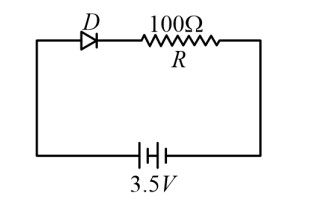
(a) 40 mA (b) 20 mA (c) 35 mA (d) 30 mA
ii. In which of the following figures, the pn diode is reverse biased?

iii. Based on the V-I characteristics of the diode, we can classify diode as
(a) bilateral device (b) ohmic device
(c) non-ohmic device (d) passive element
OR
Two identical PN junctions can be connected in series by three different methods
as shown in the figure. If the potential difference in the junctions is the same, then
the correct connections will be

(a) in the circuits (1) and (2) (b) in the circuits (2) and (3)
(c) in the circuits (1) and (3) (d) only in the circuit (1)
iv.
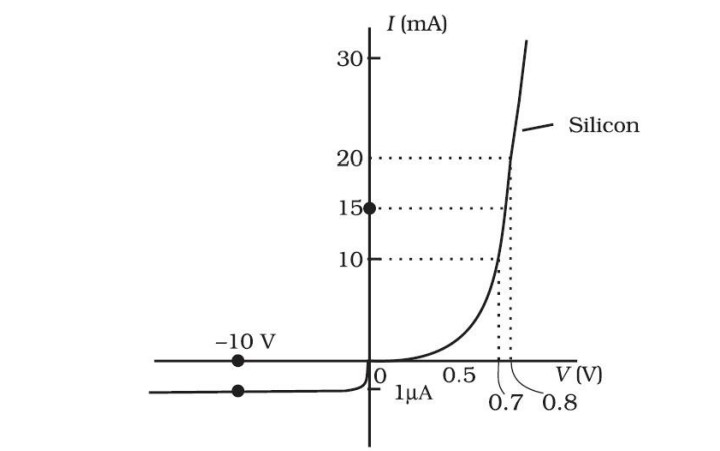
The V-I characteristic of a diode is shown in the figure. The ratio of the resistance
of the diode at I = 15 mA to the resistance at V = -10 V is
(a) 100 (b) 106
(c) 10 (d) 10-6
Question 30
Read the following paragraph and answer the questions that follow.
Types of Lenses and their combination
A convex or converging lens is thicker at the centre than at the edges. It converges
a beam of light on refraction through it. It has a real focus. Convex lens is of three
types: Double convex lens, Plano convex lens and Concavo-convex lens.
Concave lens is thinner at the centre than at the edges. It diverges a beam of
light on refraction through it. It has a virtual focus. Concave lenses are of three types:
Double concave lens, Plano concave lens and Convexo-concave lens.
When two thin lenses of focal lengths f1 and f2 are placed in contact with each other
along their common principal axis, then the two lens system is regarded as a single
lens of focal length f and 
If several thin lenses of focal length f1, f2, .... fn are placed in contact, then the
effective focal length of the combination is given by

and in terms of power, we can write
P = P1 + P2 + .... + Pn
The value of focal length and power of a lens must be used with proper sign
consideration.
i. Two thin lenses are kept coaxially in contact with each other and the focal length of
the combination is 80 cm. If the focal length of one lens is 20 cm, the focal length of
the other would be
(a) -26.7cm (b) 60cm (c) 80cm (d) 30cm
ii. A spherical air bubble is embedded in a piece of glass. For a ray of light
passing through the bubble, it behaves like a
(a) converging lens
(b) diverging lens
(c) mirror
(d) thin plane sheet of glass
iii. Lens generally used in magnifying glass is
(a) single concave lens
(b) single convex lens
(c) combination of convex lens of lower power and concave lens of lower focal
length
(d) Planoconcave lens
iv. The magnification of an image by a convex lens is positive only when the
object is placed
(a) at its focus F
(b) between F and 2F
(c) at 2F
(d) between F and optical centre
OR
A convex lens of 20 cm focal length forms a real image which is three times
magnified. The distance of the object from the lens is
(a) 13.33 cm (b) 14 cm (c) 26.66 cm (d) 25 cm

SECTION-E
Question 31
i. Draw a ray diagram for the formation of image of a point object by a thin double
convex lens having radii of curvature R1 and R2. Hence derive lens maker’s formula.
ii. A converging lens has a focal length of 10 cm in air. It is made of a material of
refractive index 1.6. If it is immersed in a liquid of refractive index 1.3, find its new
focal length.
OR
i. Define a wavefront. How is it different from a ray?
ii. Using Huygens’s construction of secondary wavelets draw a diagram showing the
passage of a plane wavefront from a denser to a rarer medium. Using it verify Snell’s
law.
iii. In a double slit experiment using light of wavelength 600nm and the angular width of
the fringe formed on a distant screen is 0.1°. Find the spacing between the two slits.
iv. Write two differences between interference pattern and diffraction pattern.







Question 32
i. Derive an expression for the capacitance of a parallel plate capacitor with air present
between the two plates.
ii. Obtain the equivalent capacitance of the network shown in figure. For a 300 V supply,
determine the charge on each capacitor.
